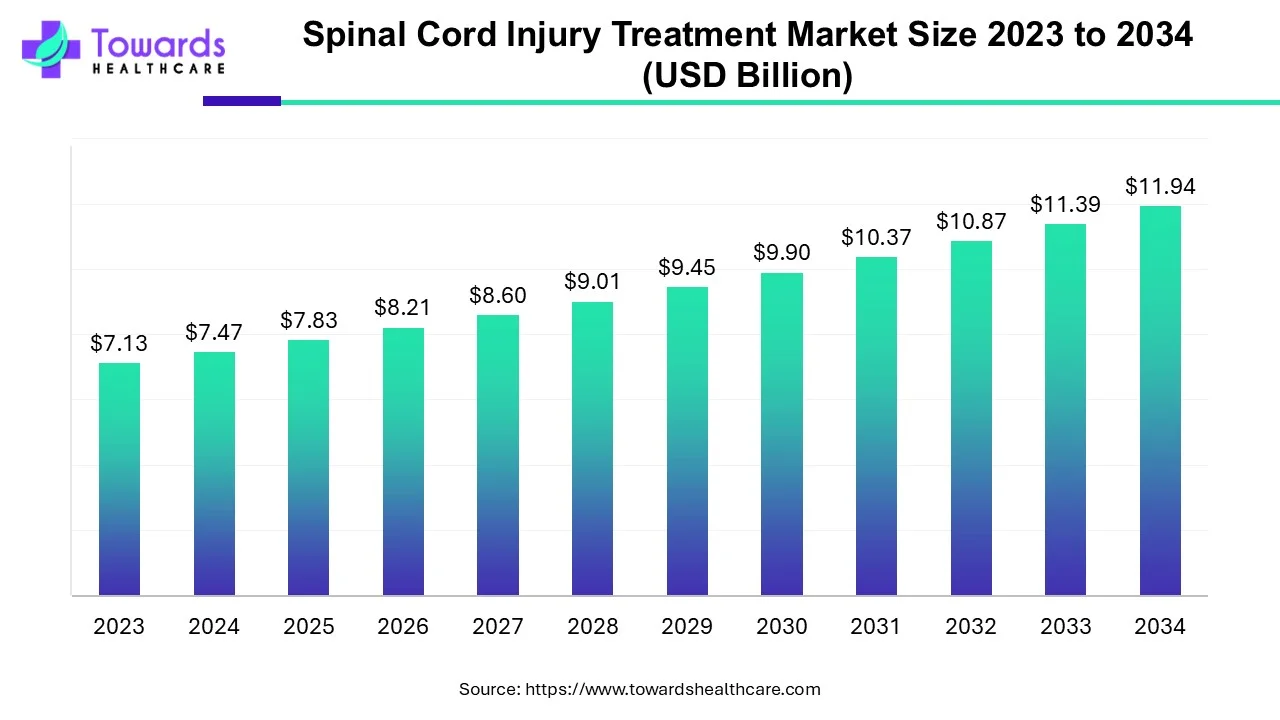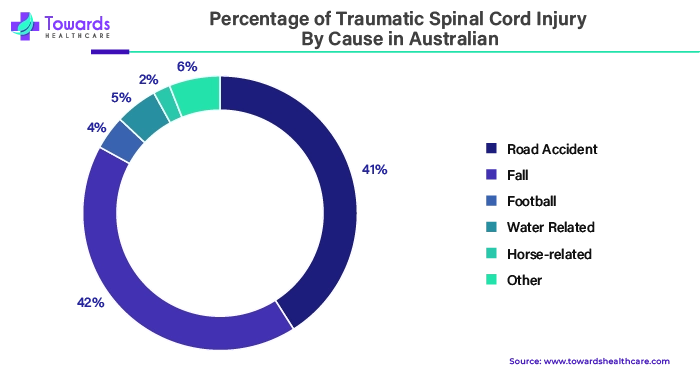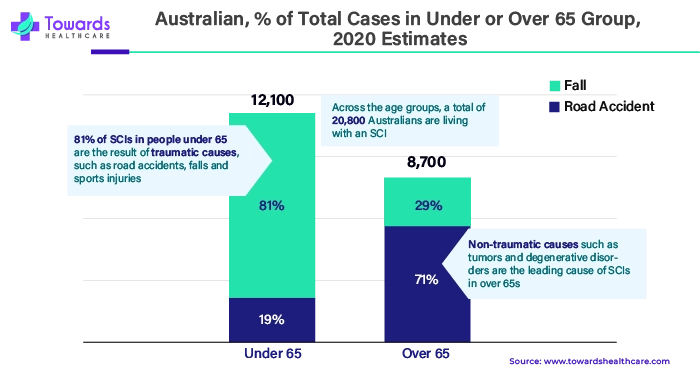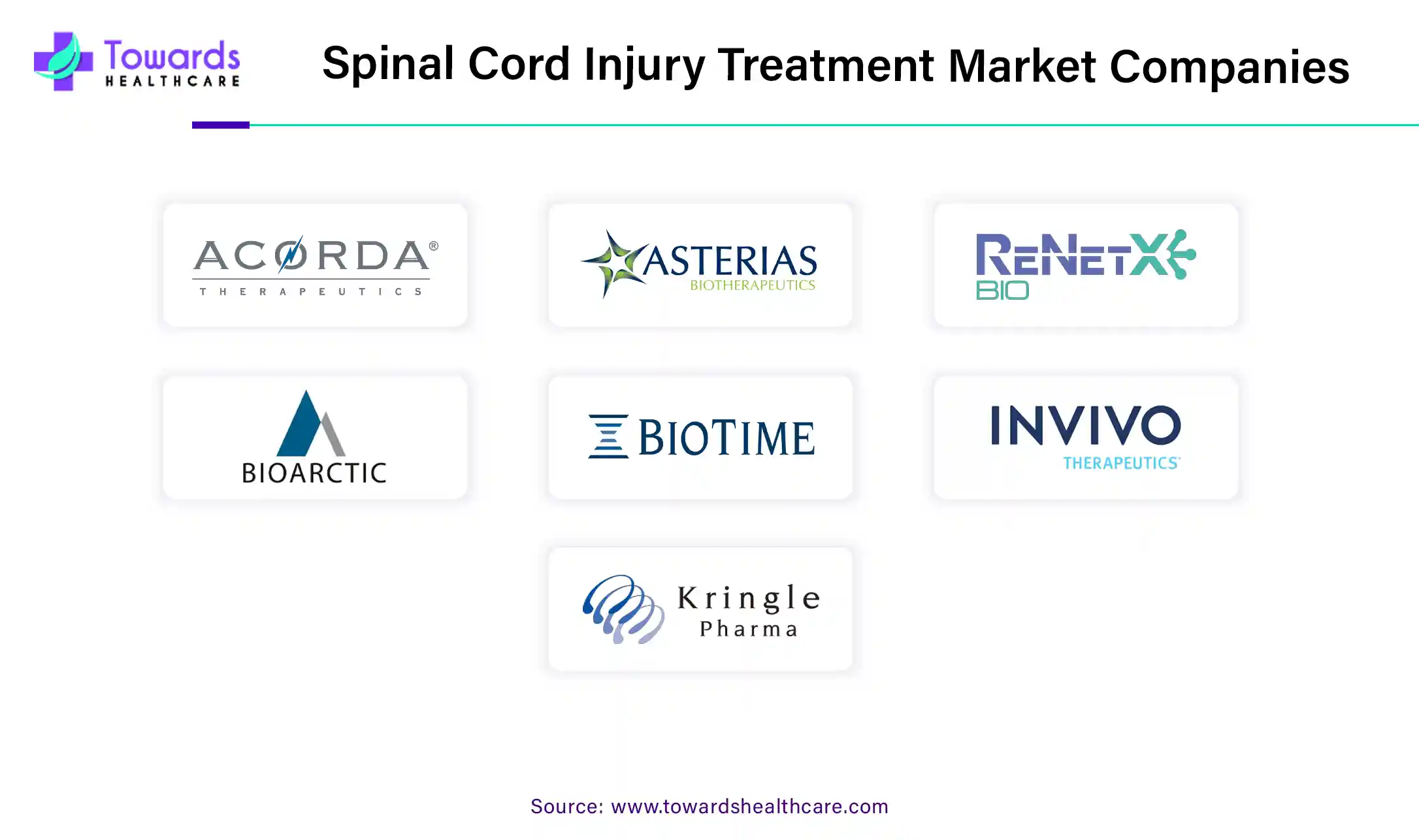December 2025

The spinal cord injury treatment market size is predicted to expand from USD 7.83 billion in 2025 to USD 11.94 billion by 2034, growing at a CAGR of 4.8% during the forecast period from 2025 to 2034.

Every year, about 18,000 new injuries to the spinal cord are reported in the United States. This is calculated using the annual incidence rate of spinal cord injury, which is 54 per 1 million. The large number of people living with spinal cord injuries highlights the importance of ongoing efforts to prevent and treat the condition.
A spinal cord injury happens when the bundle of nerves in the spine gets hurt. This can lead to changes in feeling, movement, and strength below the injury. It can be caused by direct injury or damage to the bones around the spine. Symptoms vary based on how bad it is and where it happened. A severe injury higher up can affect most of the body, causing paralysis in limbs, while lower injuries may only affect the legs.
Spinal cord injury symptoms include numbness, tingling, or loss of sensation in hands and feet, along with paralysis, pain, or pressure in the head, neck, or back. Weakness, difficulty walking, breathing, or changes in sexual function can also occur. Motor vehicle accidents and serious falls are the top causes in the US, followed by violence, sports injuries, medical mishaps, and other accidents. Risk factors include age, alcohol use, certain diseases, and not wearing proper safety gear like seat belts or sports equipment.
In the United States, motor vehicle accidents and serious falls are the leading causes of spinal cord injuries. Other causes include acts of violence (medical errors such as gunshot wounds and assaults), sports injuries, industrial accidents, and diseases. Age is a significant factor, with individuals between 16 and 30 years old being at higher risk, as well as those over the age of 65 for dangerous falls. Alcohol use, certain medical conditions, and failure to use appropriate safety equipment like seat belts or protective gear also increase the risk of spinal cord injuries.
According to estimates from the National Spinal Cord Injury Association, around 282,000 individuals in the United States are impacted by spinal cord injuries. Approximately 17,000 new cases of spinal cord injuries are diagnosed annually in the U.S. These figures underscore a growing need for spinal implants and devices due to the rising prevalence of SCI.
As our world progresses, we're seeing more instances of spinal cord injuries caused by different things like car accidents, falls, sports mishaps, and violent incidents. These injuries can be severe and require specialized treatment to help people recover.
As people grow older, their bodies undergo changes, and they become more susceptible to spine-related issues such as degenerative disc disease and spinal cord injuries. With the global population aging, more individuals are encountering these challenges.
As we age, the bones and discs in our spine can deteriorate or become more prone to injury. These changes can lead to conditions that affect the spinal cord. When the spinal cord is injured, it can result in difficulties with movement, sensation, and other bodily functions. Thus, with a growing older population, the demand for treatments addressing these spinal cord-related issues rises.
Treating spinal cord injuries often involves a combination of interventions. Some individuals may require surgery to repair their spine, while others may need rehabilitation to relearn movement and regain function. Due to the increasing number of older adults experiencing these problems, there's a heightened need for such treatments.
Healthcare providers and researchers are diligently working to develop new and improved methods for treating spinal cord injuries and age-related spine conditions. Their aim is to enhance the quality of life for those affected by these challenges. Through advancements in medical technology and rehabilitation techniques, they strive to provide better care and support for individuals with spinal cord injuries and related issues.
Scientists and doctors are working together like superheroes to help people with spinal cord injuries. They have special tools like advanced surgical techniques that can fix damaged spines very precisely. They also use something called neuroprosthetics, which are devices that can help people move even if their spinal cord is injured. It's like giving them a superpower to control their limbs with technology. Another tool they use is regenerative medicine, which helps the body heal itself. Scientists are learning how to use this to repair damaged spinal cords, so people can regain lost functions and live more normal lives.
Recent advancements in spinal cord injury (SCI) research, supported by the National Institute of Neurological Disorders and Stroke (NINDS), aim to improve the quality of life for people with spinal cord injuries.
Electrical Stimulation System:
Spinal Cord Stimulation:
Brain-Computer Interfaces (BCIs):
But it's not just about fixing the body; it's also about teaching it to adapt and thrive again. That's where rehabilitation methods come in. These methods help people with spinal cord injuries learn to move and function again through special exercises and therapies.
For instance,
All these advancements in medical technology give hope to people with spinal cord injuries. They're not just making patients better; they're also creating more ways to treat these injuries and offering new possibilities for the future. As long as scientists keep pushing the boundaries of science, they can change many lives for the better.
These injuries often result from severe trauma like car accidents or falls, causing lifelong disabilities. Due to the permanent nature of these injuries, individuals require ongoing medical care, rehabilitation, and assistive devices throughout their lives.

This growing patient population fuels demand for various treatment options, including surgical interventions, neuroprosthetics, and regenerative medicine. Surgeons use advanced techniques to repair the spine, while neuroprosthetics offer hope by restoring some lost functions through devices like exoskeletons or nerve stimulators. Regenerative medicine explores ways to repair damaged spinal cords, potentially enabling some level of recovery for those with complete injuries. Additionally, rehabilitation plays a crucial role in helping individuals adapt to their new circumstances, improving their quality of life and independence.
Even though medical technology has improved greatly, treating spinal cord injuries, especially when there's a complete loss of function, still has its challenges. When someone suffers a complete spinal cord injury, where they lose all sensation and movement below the injury site, current treatments mostly focus on managing symptoms and preventing further damage rather than fully restoring function. This means that while doctors can provide care to help reduce pain, manage complications, and prevent secondary issues like infections or pressure sores, they can't completely reverse the damage to the spinal cord. So, individuals with complete spinal cord injuries may not regain full movement or sensation even with the best available treatments.
This limitation is due in part to the spinal cord's complexity. It functions as a nerve superhighway, carrying messages from the brain to the rest of the body. When it is injured, the connection between the brain's neurons and the body is disrupted, making it difficult for signals to pass. Another issue is that cells in the spinal cord do not repair themselves as readily as cell in other part of the body. So, while doctors can use various therapies such as surgery, medications, or physical therapy to help, they cannot always completely restore the damaged nerves.
Researchers are continuously working to find new treatments that could help repair the spinal cord and restore function, but it's a complex puzzle that hasn't been fully solved yet. Until then, the focus remains on providing the best possible care to manage symptoms, prevent complications, and improve the quality of life for individuals living with complete spinal cord injuries.
North America is a big hub for treating spinal cord injuries. In this hub, there are different areas where people work to help those with spinal cord injuries. some areas like the United States and Canada, have a lot of resources and facilities for treating this injury. They have hospitals, clinics, and research centers where doctors and scientists are working hard to find new treatments and therapies. As the prevalence of spinal injuries increases in the United States, it drives the growth of the spinal cord injury treatment market.
For instance,
The geographical landscape for spinal cord injury treatment in Asia Pacific looks at how treatments for spinal cord injuries are spread out across countries like China, Japan, India, and Australia. It involves analyzing factors such as the quality and accessibility of healthcare infrastructure, including hospitals and rehabilitation centers. Regulations also play a significant role, as different countries may have varying approval processes for new treatments or medical devices. The availability of medical professionals trained in treating spinal cord injuries is crucial. Cultural attitudes towards disabilities and healthcare may impact the availability and acceptance of treatment.
For instance,

Pharmaceutical companies develop drugs to alleviate symptoms, reduce inflammation, or promote neuroprotective or aerogeneration after spinal cord injury patients. Companies offer innovative rehabilitation devices, robotics, and assistive technologies to enhance mobility and function for spinal cord injury patients. Also, the manufacturer of spinal cord stimulators and other neurostimulation devices aimed at managing pain and improving function in spinal cord injury patients. Providers of imaging technologies and diagnostic tools for accurate assessment and monitoring of spinal cord injuries.
In April 2025, ARC-EX, a device for spinal cord injury rehabilitation, received FDA approval, thanks in part to KITE research. A novel therapy for people with spinal cord injuries has been approved for medical use in the U.S., and the KITE Research Institute played an important role in its success.

By Injury Type
By Treatment
By End User
By Geography
December 2025
December 2025
November 2025
November 2025